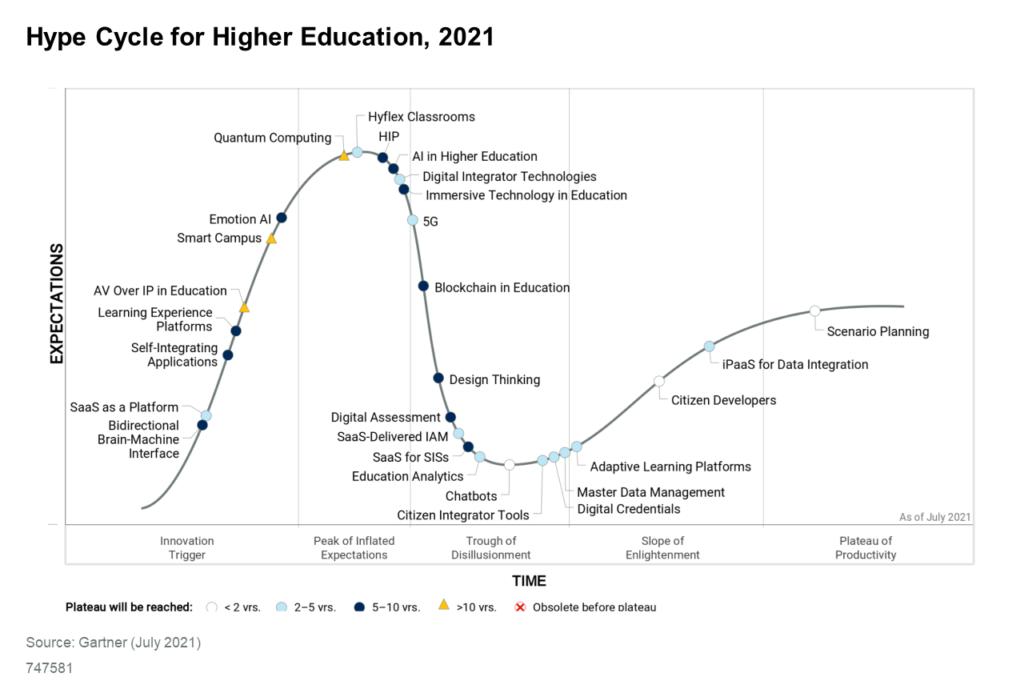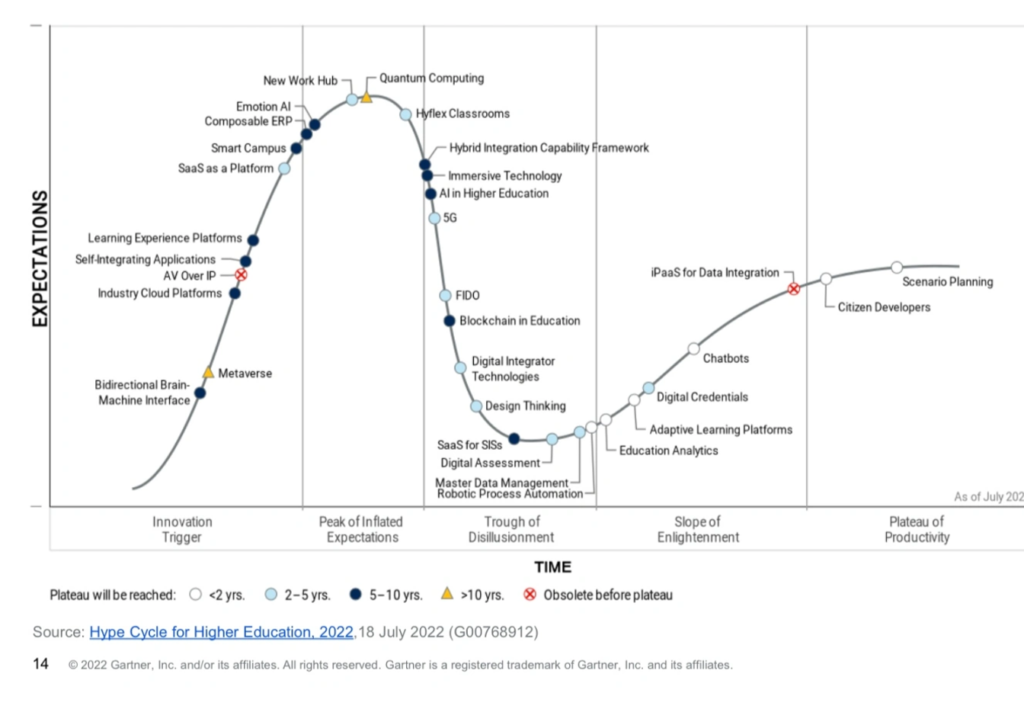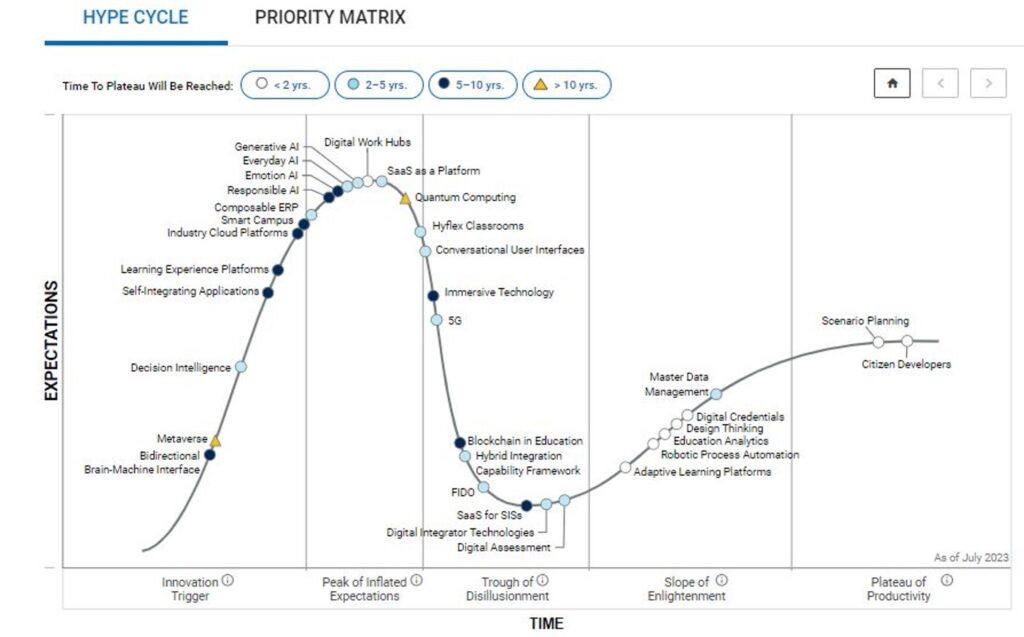The journey of HyFlex education through the phases of the Gartner Hype Cycle offers a fascinating glimpse into the dynamic interplay between its particular use of technology and the pedagogical innovation driving change. As we explore this progression, we can glean insights into how the implementation of HyFlex in our own institutions might continue to shape learning environments in higher education. In which phase do you see yourself now? How about in 2-3 years?
The Gartner Hype Cycle phases can be used to describe and predict the path of HyFlex (as both a set of technologies and a “soft” technology – pedagogy) in higher education. These five phases include:
-
Technology Trigger: The initial emergence of the technology, generating interest and media buzz.
-
Peak of Inflated Expectations: High expectations are fueled by hype and speculative success stories.
-
Trough of Disillusionment: Realization of the technology’s limitations leading to disappointment and reduced interest.
-
Slope of Enlightenment: Gradual understanding and practical applications of the technology begin to crystallize as more success stories emerge.
-
Plateau of Productivity: The technology becomes widely accepted and integrated into regular use.
HyFlex may not be the best course approach for all disciplines and programs, but if it were implemented more broadly it certainly could improve the learning experience for many more students than it is currently. HyFlex providers (faculty, administrators, leadership teams, and staff) should focus on refining their HyFlex offerings (courses, programs, and learning designs), managing expectations and counseling patience, and demonstrating real-world value (supported by local evidence of success) as they guide their HyFlex implementations from one phase to the next, ensuring adaptation and support at each stage to reach widespread adoption.
Figure 1. HyFlex Classrooms on the Gartner Hype Cycle in 2021

Phase 1. Technology Trigger: The Origins of HyFlex
A you probably know, the concept of Hybrid-Flexible, or HyFlex, courses originated at San Francisco State University during the 2006-2007 academic year. (Beatty, 2019) The HyFlex model was designed to provide students with the flexibility to choose between attending classes in person, participating online in real-time, or later in asynchronous mode. This innovative model aimed to combine the best aspects of face-to-face and online learning, accommodating diverse learner needs while maintaining rigorous academic standards. In other words, HyFlex lets students decide how they want to attend classes: in person, online live, or by participating fully online later asynchronously. It was all about giving students the freedom to choose what worked best for them, and them meeting them with high-quality learning experiences.
This initial trigger launched HyFlex in many schools, often with specific faculty or programs looking for highly contextualized solutions to their unique set of challenges creating single or small groups of HyFlex courses that were tested to see if students could really learn as well or better in this approach, and if teachers could still teach well in every mode. (See the HyFlex Research Bibliography (https://www.hyflexlearning.org/bibliography/) for links to more than 100 early studies from 2019 and earlier.)
Stage 2. Peak of Inflated Expectations: The COVID-19 Catalyst
The global COVID-19 pandemic of 2020-2022 served as a significant catalyst for the widespread adoption of the HyFlex model. When COVID-19 hit, schools everywhere had to switch up fast to serve students fully online, and then bring back some students to campus as quickly as they could. HyFlex became a “superstar” almost overnight. It was a proven solution for keeping classes going either online or in-person (really both) almost no matter what was happening in the world. Many educational institutions worldwide rapidly embraced the HyFlex flexible learning format as a means to continue student learning and faculty teaching amidst fluctuating public health guidelines. The urgency of the situation led to a surge in interest and implementation, as politicians, administrations, educators and students alike sought effective ways to maintain learning continuity.
During this period, the expectations from HyFlex soared, often viewed as a panacea for all educational challenges posed by the pandemic. (See Figures 1. and 2.) But some institutions didn’t complete the necessary initial step in implementing HyFlex: preparing the classrooms and technology; platforms, preparing faculty to teach in multiple modes at once, developing course models that supported multi-mode learning, and preparing students to learn well in any mode they might choose. (See the HyFlex Research Bibliography (https://www.hyflexlearning.org/bibliography/) for links to more than 100 studies from the COVID-19 pandemic years 2020-2022.)
The COVID-19 pandemic had a significant impact on the adoption and popularity of HyFlex (hybrid-flexible) courses in higher education from 2020 to 2023. A few of the key points are briefly outlined below. Which of these did your institution, and you personally experience? How did they impact your adoption (or not) of HyFlex?
A. Necessity for Flexible Learning Options
-
Social distancing requirements and lockdowns during the pandemic necessitated flexible learning options that allowed students to attend classes either in-person or remotely. HyFlex courses provided a solution by offering synchronous in-person and online attendance modes simultaneously.
-
The pandemic disrupted traditional in-person and fully online course delivery, prompting institutions to explore alternative models like HyFlex to accommodate students’ diverse needs and locations.
B. Increased Adoption and Experimentation with HyFlex
-
Many higher education institutions adopted or piloted HyFlex courses during the pandemic as a way to maintain educational continuity while adhering to health and safety guidelines.
-
The pandemic served as a catalyst for institutions to experiment with and evaluate the viability of the HyFlex model, leading to discussions, research, and sharing of best practices.
-
Some institutions conducted pilot programs or offered a limited number of HyFlex courses initially to assess their suitability and gather feedback from faculty and students.
C. Addressing Student Needs and Equity
-
HyFlex courses aimed to increase access and equity for students who faced barriers to attending traditional in-person or fully online classes due to various circumstances, such as health concerns, geographic locations, or personal obligations.
-
The flexibility offered by HyFlex courses appealed to students during the pandemic, allowing them to choose the attendance mode that best suited their needs and preferences.
Overall, the COVID-19 pandemic accelerated the adoption of HyFlex courses in higher education and to some extent in K12 (at the higher grade levels) as a response to the need for flexible learning options, social distancing requirements, and the desire to provide equitable access to education during a very disruptive time.
Figure 2. HyFlex Classrooms on the Gartner Hype Cycle in 2022

Stage 3. Trough of Disillusionment: Reassessment and Realignment
The post-pandemic years of 2022-2023 marked a period of reassessment for many institutions. There were many “bumps” along the way. Some schools reverted to full in-person instruction in an effort to recover the traditional campus life and experience that was valued pre-COVID-19. They were hoping to recover their pre-pandemic enrollment numbers, at least. (Some did, and many have not yet; many campuses are operating with 10-20% fewer students in 2024 than they served in 2019. See NCES statistics https://nces.ed.gov/fastfacts/display.asp?id=98 )
When an institution starts experiencing a technology shift from the peak of inflated expectations to the trough of disillusionment, these characteristics are observed and experienced: (localized to HyFlex)
-
Expectation Adjustment: Initial excitement and overly optimistic expectations about HyFlex learning and teaching give way to the reality of practical implementation challenges and limitations (and there can be many!).
-
Market Consolidation: Some early adopters of HyFlex may abandon the technology, leading to a shakeout of support for HyFlex, especially for administrators fixated on the face-to-face learning experience for all of their students. The strongest proponents of HyFlex and the most viable technologies continue to develop. We see this in instructions more focused on public and expansive access to their learning opportunities.
-
Focus on Refinement: HyFlex providers should concentrate on improving the technology’s robustness, usability, and integration capabilities. It’s crucial to gather user feedback to address real-world application issues. And change your HyFlex approach based on your local evidence of need, effectiveness, and sustainability. Some HyFlex courses and programs have moved to “online HyFlex” because they no longer see the need for face-to-face instruction based on student behavior. See two recent blog posts: https://www.hyflexlearning.org/2024/04/29/students-value-hyflex/ and https://www.hyflexlearning.org/2023/04/13/bimodal-high-touch/
-
Clear Communication: It is important to manage expectations by communicating the realistic capabilities and benefits of HyFlex learning, not just its potential. Some courses cannot fully support online learning, so they create “hybrid HyFlex” courses with some learning outcomes available in the classroom and online, and others just available in the classroom (or practice lab).
The shift in institutional strategy and implementation in 2022-2023 highlighted some of the challenges and limitations of the HyFlex model, such as the increased demand on faculty to manage multiple modes of delivery and the varying degrees of student engagement across different formats. (See Figure 3.) Not only do faculty have to redesign their courses for multiple modes but they have to learn to facilitate learning in multiple modes. Not all faculty are willing to do so, nor do all have adequate professional development and support networks for this shift. The initial excitement about HyFlex in some places gave way to a more nuanced understanding of the model’s implementation requirements, its “best-fit” applicability, and its initial effectiveness given imperfect support systems. (See the HyFlex Research Bibliography (https://www.hyflexlearning.org/bibliography/) for links to more than 50 studies from the post-COVID-19 pandemic years 2023-2024.)
Figure 3. HyFlex Classrooms on the Gartner Hype Cycle in 2023

As a new technology transitions from the Trough of Disillusionment to the Plateau of Productivity on the Gartner Hype Cycle, it generally exhibits these characteristics: (localized to HyFlex)
-
Maturation: The HyFlex technology and pedagogy become more reliable and its performance improves as developers address the flaws discovered during earlier stages. We evaluate, learn, and adapt!
-
Broad Adoption: The HyFlex method sees increased acceptance and adoption across a wider range of institutions, disciplines, and course levels. HyFlex is now used in graduate, undergraduate, high school, professional development, and some corporate training settings.
-
Integration: It becomes better integrated with other technologies and systems, enhancing its usability and expanding its applications. HyFlex learning and teaching is being negotiated with teaching unions, policies are being developed by academic senates, flexible learning is being discussed with institutional governing boards, state governments (funders), regional and national accrediting agencies, and more. Campus systems (SIS, LMS, bulletins) are being updated to include the unique characteristics of HyFlex learning (scheduling, participation expectations, flexibility limitations for certain students, etc.).
To successfully navigate this phase, HyFlex providers should focus on:
-
Solidifying Use Cases: Clearly demonstrating and communicating the practical and effective use cases of the technology. Rely on existing literature but also develop local evidence to support implementation decisions.
-
Improving User Experience: Enhancing ease of use and reducing barriers to entry to broaden HyFlex’s appeal. Teachers are supported with course design and development support, startup time is provided for faculty new to HyFlex, and students are provided with technology and skills support.
-
Establishing Partnerships: With HyFlex, support is shared among units within and perhaps across institutions – especially within multi-campus systems. Technology providers and institutional IT/AV leadership form strategic partnerships to expand the development and use in various application scenarios. No “single-mode-only technology” anymore, except for special cases.
Stage 4. Slope of Enlightenment: Strategic Expansion and Refinement
By 2023-2024, many campuses began to strategically expand their HyFlex offerings, driven by a renewed understanding of today’s higher education (HE) student who desires flexibility. They got smarter about using HyFlex. They started fixing what didn’t work in their initial, hurried implementations, doubling down on what did work well, like improving technology and training teachers how to better use it (moving beyond “emergency remote instruction”). For these campuses, it’s all about making learning as flexible and supportive as possible, adapting to what students need today (not in 2019). And the education statistics show that some schools are actually growing enrollment, often due in some part to increasing the participation flexibility offered to students.
This slope of enlightenment for technology is characterized by targeted improvements, informed by the lessons learned during earlier implementations. After the rush of investment in classroom AV to make all rooms “Zoom ready”, campus IT/AV staff are now focusing on enhancing technological infrastructure, faculty development units are providing faculty with targeted professional development, and faculty and academic leaders are refining pedagogical approaches and expectations to optimize learning outcomes across all formats. If this is happening at your campus, you’ll know it!
See the Unit III Case Reports in the Hybrid-Flexible Course Design book for many (18 and counting) stories of campuses and faculty getting to this point in the process. (https://edtechbooks.org/hyflex/hyflex_cases).
Stay tuned for Figure 4. HyFlex Classrooms on the Gartner Hype Cycle in 2024 (not available until July 2024)
Stage 5. Plateau of Productivity: Looking to the Future
Looking ahead, the strategic use of HyFlex is poised to play a crucial role in addressing challenges such as declining enrollment and the need to serve more students with limited resources. The future of higher education looks promising as faculty, administrators, and leadership groups continue to embrace and refine the HyFlex model to meet the evolving needs of a diverse student body. A growing number of schools will be using HyFlex more wisely to tackle big issues like dropping student numbers, developing efforts to attract potential student populations still unserved (or underserved), and operating more efficiently with already stretched resources becoming even thinner. HyFlex pedagogy and technology are settling into a phase where their benefits are well understood and are being implemented more broadly with a realistic set of expectations.
The goal is clear: make learning accessible, equitable, and engaging for everyone. With ongoing tweaks and improvements, HyFlex can help schools be more adaptable and inclusive, ready for whatever comes next.
To learn more about the HyFlex movement:
-
explore the resources at the HyFlex Learning Community (https://hyflexlearning.org),
-
prepare to design and teach a HyFlex course by participating in professional development (https://www.hyflexlearning.org/workshops/),
-
review the hundreds of studies providing evidence of learning impact, student impact, and the faculty experience with HyFlex linked in the HyFlex Research Bibliography (https://www.hyflexlearning.org/bibliography/),
-
and if you are interested in current trends and ongoing research, join us on June 27, 2024 online for the 2nd Annual HyFlex Collaborative Conference (https://aatlased.org/hyflex-collaborative/hyflex-collaborative-conference-2024/).
Author
-

Dr. Brian Beatty is Professor of Instructional Design and Technology in the Department of Equity, Leadership Studies and Instructional Technologies at San Francisco State University. At SFSU, Dr. Beatty pioneered the development and evaluation of the HyFlex course design model for blended learning environments, implementing a “student-directed-hybrid” approach to better support student learning.
View all posts